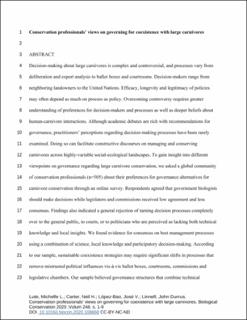| dc.contributor.author | Lute, Michelle L. | |
| dc.contributor.author | Carter, Neil H. | |
| dc.contributor.author | López-Bao, José V. | |
| dc.contributor.author | Linnell, John Durrus | |
| dc.date.accessioned | 2020-09-17T09:41:39Z | |
| dc.date.available | 2020-09-17T09:41:39Z | |
| dc.date.created | 2020-07-10T15:03:43Z | |
| dc.date.issued | 2020 | |
| dc.identifier.citation | Biological Conservation. 2020, 248 1-9. | en_US |
| dc.identifier.issn | 0006-3207 | |
| dc.identifier.uri | https://hdl.handle.net/11250/2678211 | |
| dc.description.abstract | Decision-making about large carnivores is complex and controversial, and processes vary from deliberation and expert analysis to ballot boxes and courtrooms. Decision-makers range from neighboring landowners to the United Nations. Efficacy, longevity and legitimacy of policies may often depend as much on process as the policy itself. Overcoming controversy requires greater understanding of preferences for decision-makers and processes as well as deeper beliefs about human-carnivore interactions. Although academic debates are rich with recommendations for governance, practitioners' perceptions regarding decision-making processes have been rarely examined. Doing so can facilitate constructive discourses on managing and conserving carnivores across highlyvariable social-ecological landscapes. To gain insight into different viewpoints on governance regarding large carnivore conservation, we asked a global community of conservation professionals (n = 505) about their preferences for governance alternatives for carnivore conservation through an online survey. Respondents agreed that government biologists should make decisions while legislators and commissions received low agreement and less consensus. Findings also indicated a general rejection of turning decision processes completely over to the general public, to courts, or to politicians who are perceived as lacking both technical knowledge and local insights. We found evidence for consensus on best management processes using a combination of science, local knowledge and participatory decision-making. According to our sample, sustainable coexistence strategies may require significant shifts in processes that remove mistrusted political influences visà-
vis ballot boxes, courtrooms, commissions and legislative chambers. Our sample believed governance structures that combine technical expertise with local perspectives in a co-management framework may best withstand tests of time and controversy. | en_US |
| dc.language.iso | eng | en_US |
| dc.rights | Attribution-NonCommercial-NoDerivatives 4.0 Internasjonal | * |
| dc.rights.uri | http://creativecommons.org/licenses/by-nc-nd/4.0/deed.no | * |
| dc.subject | Conservation social science | en_US |
| dc.subject | Predators | en_US |
| dc.subject | Policy preferences | en_US |
| dc.subject | Wildlife governance | en_US |
| dc.subject | Institutions | en_US |
| dc.title | Conservation professionals' views on governing for coexistence with large carnivores | en_US |
| dc.type | Peer reviewed | en_US |
| dc.type | Journal article | en_US |
| dc.description.version | acceptedVersion | en_US |
| dc.subject.nsi | VDP::Zoologiske og botaniske fag: 480 | en_US |
| dc.subject.nsi | VDP::Zoology and botany: 480 | en_US |
| dc.source.pagenumber | 1-9 | en_US |
| dc.source.volume | 248 | en_US |
| dc.source.journal | Biological Conservation | en_US |
| dc.identifier.doi | 10.1016/j.biocon.2020.108668 | |
| dc.identifier.cristin | 1819211 | |
| dc.relation.project | Norges forskningsråd: 251112 | en_US |
| cristin.ispublished | true | |
| cristin.fulltext | postprint | |
| cristin.qualitycode | 2 | |

